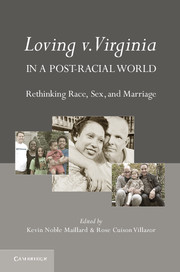Book contents
- Frontmatter
- Contents
- About the Contributors
- Acknowledgments
- Foreword
- Introduction Loving v. Virginia in a Post-Racial World
- Part One Explaining Loving v. Virginia
- Part Two Historical Antecedents to Loving
- Part Three Loving and Interracial Relationships: Contemporary Challenges
- Part Four Considering the Limits of Loving
- 11 Black Pluralism in Post-Loving America
- 12 Political Blackness
- 13 Finding a Loving Home
- Part Five Loving Outside the U.S. Borders
- Part Six Loving and Beyond: Marriage, Intimacy, and Diverse Relationships
- Permission Granted
- Index
- References
13 - Finding a Loving Home
Published online by Cambridge University Press: 05 July 2012
- Frontmatter
- Contents
- About the Contributors
- Acknowledgments
- Foreword
- Introduction Loving v. Virginia in a Post-Racial World
- Part One Explaining Loving v. Virginia
- Part Two Historical Antecedents to Loving
- Part Three Loving and Interracial Relationships: Contemporary Challenges
- Part Four Considering the Limits of Loving
- 11 Black Pluralism in Post-Loving America
- 12 Political Blackness
- 13 Finding a Loving Home
- Part Five Loving Outside the U.S. Borders
- Part Six Loving and Beyond: Marriage, Intimacy, and Diverse Relationships
- Permission Granted
- Index
- References
Summary
Although Loving has forever changed the lives of interracial couples by allowing them to legally marry in every state, it has not led society to embrace all multiracial couples and families. More than forty years after Loving, 95 percent of all individuals marry a person of the same race. Additionally, interracial couples continue to face both physical and verbal threats to their existence, and they also continue to be largely invisible from the media, textbooks, and other types of communications.
In other words, more than forty years since the Supreme Court decided Loving, we, a black woman and a white man who are married and reside with our three biracial children in Iowa, continue to live the legacy of Loving’s named plaintiffs, Mildred and Richard. Although we benefit from the Lovings’ courage and courtroom victory through a range of legal privileges and protections that stem from the Supreme Court’s recognition of their fundamental right to marry regardless of race, we also endure the legacy of their social lives. Even after the historic decision, the Lovings’ lives were affected by both conscious discriminatory attitudes and unconscious biases.
Today, society and law continue to work together to frame the normative ideal of intimate couples and families as not just monoracial but also heterosexual. In this chapter, however, we focus solely on the issue of race and the privilege of monoraciality among intimate couples and do not address the privilege of heterosexuality among couples, which is readily evident within our society. As our primary focus, we analyze contemporary challenges that interracial couples, particularly blackwhite couples, may face in the public eye. First, we identify and explicate both the social and legal ways in which interraciality may affect and alter the treatment and recognition of multiracial, heterosexual couples and their families. Thereafter, we utilize housing discrimination law as one example of the way in which law can render multiracial couples and families invisible and thus fail to address fully the harms to such groups.
- Type
- Chapter
- Information
- Loving v. Virginia in a Post-Racial WorldRethinking Race, Sex, and Marriage, pp. 181 - 196Publisher: Cambridge University PressPrint publication year: 2012
References
- 2
- Cited by

